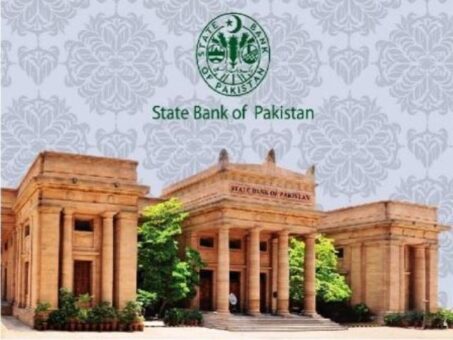KARACHI: State Bank of Pakistan (SBP) on Friday issued procedure for disbursement of loan to unemployed youth under Prime Minister’s Kamyab Jawan Youth Entrepreneurship Scheme (PMKJ-YES).
In a circular issued to all chief executives of banks and development financial institutions, the SBP said that executing agencies (EAs) shall evaluate loan applications of unemployed youth as per parameters of PMKJ-YES approved by the Federal Cabinet and circulated by the State Bank of Pakistan to all banks vide its IH&SMEFD Circular No. 08 of 2019 dated July 11, 2019.
The loan facility for a borrower shall be sanctioned and disbursed by the EA after completion of documentation formalities.
These loans shall be entitled for service charges subsidy and credit losses subsidy. No further evaluation on eligibility of borrowers would be conducted by the SBP.
The government has launched PM Kamyab Jawan Youth Entrepreneurship Scheme (PMKJ-YES) to provide concessional loans to youth for establishing or extending business enterprises thereby promoting entrepreneurship and reducing unemployment and poverty in Pakistan.
The SBP has issued necessary instructions to all banks through IH&SMEFD Circular No. 08 dated July 11, 2019. All loans disbursed under PMKJ-YES shall be reported to SBP under Small Enterprise Financing category.
Under the Scheme, loans are segregated into two tiers i.e. Tier 1 (T1) loans from Rs. 100,000 to Rs. 0.5 million and Tier 2 (T2) loans – above Rs 0.5 million and up to Rs 5 million.
The loans will be provided through the banking system at service charges of 6 percent per annum. for TI loans and 8 percent p.a. for T2 loans, while the rate of return for banks working as EAs for PMKJ-YES would be KIBOR (6- Months offer) + 500 bps for T1 loans and KIBOR (6- Months offer) + 400 bps for T2 loans with KIBOR to be reset bi-annually.
The government shall absorb the difference between the rate of return for EAs and end user rate as service charges subsidy, the SBP said.
Besides, GOP will also bear credit losses (principal portion only) on the disbursed portfolio of the banks up to 50 percent in case of T1 loans and up to 10 percent in case of T2 loans.
As per SBP’s Prudential Regulations for Small Enterprise Financing, loans are classified as loss on objective basis (time based criteria) when default period is 18 months or more or on subjective basis.
Hence, for determination of admissible credit losses against EA’s total PMKJ-YES disbursed portfolio at the end of each quarter, only loan cases classified under loss category as per SBP SME Financing PRs will be considered.
The SBP said that the payment of service charges subsidy to EAs will be made through SBP’s operational arm viz Development Finance Support Department (DFSD), SBP BSC Head Office Karachi.
The EAs shall prepare and submit claims to DFSD for receiving government service charges subsidy on outstanding principal amount of their regular PMKJ-YES portfolio up to expiry of each individual loan.
In case of a loan becoming non-performing, no service charges subsidy will be paid after being classified as ‘Loss’ as per SBP PRs for SME Financing.
The EAs claims shall contain particulars of each individual loan along with calculations of subsidy based on relevant six months KIBOR used. The service charges subsidy claim should be duly vetted by internal audit department of the EA. The audited claim along with a certificate from EA relating to eligibility of borrower for PMKJ-YES and correctness of the subsidy amount shall be submitted to DFSD within 15 working days after the end of respective quarter for payment of service charges subsidy.
DFSD, SBP BSC shall scrutinize subsidy claim of EAs within 15 working days after receipt of complete information from EAs.
DFSD shall ascertain that calculations of EAs subsidy claim are correct and applicable KIBOR rate has been used by the EAs.
Thereafter, DFSD shall submit scrutinized claims to Finance Division for release of funds. After receiving funds from GoP, DFSD will advise SBP BSC Karachi for crediting the subsidy amount in respective EA’s account maintained at SBP BSC Karachi.
Banking Inspection Department of State Bank during regular inspection of the EAs shall conduct inspection of their PMKJ-YES portfolio on sampling basis using its own sampling techniques.
SBP inspectors shall randomly select credit files and review them from the perspective of eligibility of borrowers under the Program, status of loan (regular or NPL) and GOP subsidy claim.
The BID inspection report section on PMKJ-YES shall be used as an important input for reviewing the Scheme and assessing its effectiveness in fulfilling the government objective of promoting youth entrepreneurship in the country.
On behalf of government, payment of credit losses subsidy to EAs will be made up to 50 percent in case of TI loans and up to 10 percent in case of T2 loans on their disbursed portfolio under the Scheme on quarterly basis through Development Finance Support Department (DFSD), SBP BSC Head Office Karachi.
EAs shall prepare claims for submission to DFSD, SBP BSC for receiving payment on account of credit losses subsidy from the government on their disbursed PMKJ-YES portfolio. The list containing details of individual loans classified as loss as per SBP SME PRs and calculation of credit loss subsidy based on total disbursed PMKJ-YES portfolio of EAs at the end of respective quarter shall be submitted to DFSD. EAs claim in this respect should be duly vetted by their internal audit department. The audited claim along with a certificate from EA relating to correctness of the claimed amount shall be submitted to DFSD within 15 working days after the end of respective quarter.
DFSD, SBP BSC shall scrutinize credit loss subsidy claim of EAs within 15 working days after receipt of complete information from EAs and ascertain that calculations of EAs loss claim are correct.
Thereafter, DFSD will forward admissible claims of EAs to Finance Division, GoP, for release of funds. After receiving funds from Finance Division, DFSD will advise SBP BSC Karachi office for crediting the approved subsidy claim in respective EAs account maintained at SBP BSC Karachi Office.
EAs will return excess amount arising, if any, to DFSD, in case movement in their PMKJ-YES portfolio causes amount of credit loss to be less than/falls below 50 percent in case of T1 loans and 10 percent in case of T2 loans of total disbursed portfolio of EA at the end of reporting Quarter.



